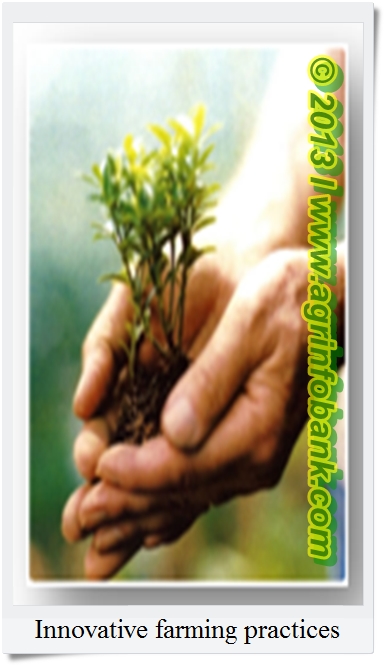Agriculture

- Classification Of Agricultural Farming System
There are some ways to classify the farming system of agriculture. We can classify this type farming on the basis of agricultural land availability, on the basis of farm enterprise, on the basis of ownership of the area of the farming land, on the basis...
- Some Terminology Related To Multiple Cropping
Multiple Cropping ( sugarcane with vegetable )AGRO-FORESTRY: when are grown along with the agricultural crops ( annual crop ) and livestock, then it is called agroforestry. Example mango with rice. PRECISION AGRICULTURE: It is a concept of agriculture...
- Farmers Can Benefit From Precision Agriculture
June 24, 2013 Farmers in developing countries could take advantage of the emerging field of precision agriculture without needing the expensive technology usually associated with it: This was stated by Speakers at a conclusion of 2-day International Seminar...
- Resource Conserving Agri-technologies
Authors: Habib Ullah, Dr. Ehsanullah and Dr. Shakeel Ahmad Anjum, Associated with Agro-biology lab, department of Agronomy, University of Agriculture Faisalabad. Pakistan is an agricultural country. Contribution of agriculture sector in the GDP...
- Conservation Agriculture-way To Prosperity
Ali Ahsan BajwaDepartment of Agronomy, University of Agriculture, Faisalabad.38040, PakistanImportant Note: © Copyright to Agriculture Information Bank (www.agrinfobank.com), Without Publisher and Author Permission Reproduce/Reprint/Republished by any...
Agriculture
Innovative farming practices: Why and How?
 |
| Mohsin Tanveer (Author) |
Presently globalization, over exploitation of resources, variation in climate and tremendously rising population are putting a great challenge for agriculturist to meet food demand. Food security is principle responsibility of an agriculturist. Green house gases, anthropogenic activities, global warming is decreasing production potential of a specific area by changing its microclimate.
Farmers adopt agriculture for their livelihood and such herculean problems are agitating them to deny further adoption of agriculture profession. In that context, there is dire need of innovative farming practices. As cost effective, self sufficiency, low input agricultural practices have always been a quest and an interest for farmers and researchers.

Agriculture has trusted heavily on conventional methods to improve and sustain crop production. Conventional methods include use of chemicals to control pest and weeds, employing synthetic fertilizer that are not economical and environment friendly, over cultivation of land. Although conventional methods have potential to give high yield but under conventional practices, there is limited opportunity to solve such problems and to reduce their impact on population. Now, it is being thought that these conventional methods might be responsible for creating such problems.
Innovative farming practice is defined as Good Agricultural Practice that stands on four pillars of environment sustainability, socio- economical adaptability and quality food production. Some practices are employed to develop cropping systems and some includes use of natural and biologically active materials. Below are few approaches:
1. Biopesticides: These are certain types of pesticides derived from such natural materials that are environment friendly like from animals, plants, bacteria, and certain minerals. Biopesticides are usually inherently less toxic than conventional pesticides, and generally affect only the target pest and closely related organisms, in contrast to broad spectrum, conventional pesticides that may affect organisms. These biopesticides are very easy to made, handle and apply. Like the introduction of Bacillus thuringenesis ( Bacteria) in cotton makes it protective against the attack of worms.
2. Biofertillizers: Biofertilizers are used to improve the fertility of the land using biological wastes. It does not contain any chemicals which are detrimental to the living soil. They are extremely beneficial in enriching the soil with those micro-organisms, which produce organic nutrients for the soil and help combat diseases. The farm produce does not contain traces of hazardous and poisonous materials. Biochar, soil microbe?s cultures are very attractive in that context. The purpose of fertilizer application is to provide essential nutrients to plants for their better growth.
3. Use of natural growth promoters: Synthetic growth promoters have little adverse effects but in long run they cause many diseases in children. Under climate change scenario, application of growth promoters is necessary either through foliar application or through inoculation/priming of seeds. Allelopathic water extracts have potential to act as natural growth promoters like Moringa leaf extract. They have no adverse effects on food quality. They are very cost effective and can be made at any place.
4. Cropping systems: The development of different cropping systems seems to be affective to enhance crop production and to reduce cost of production. In that context some systems are discussed and a very few research is being done on that in world.
(A)Relay cropping system: It is a type of intercropping that aims to increase land use efficiency, reduce cost of production, maintain biodiversity per unit area. It helps the farmers for timely sowing of a crop. Simply it is process of surface seeding of a crop in to standing crop which has desired yield advantage. It is very simple method and can be employed at any place. Stubbles of preceding crop act as organic matter in soil thus reduce extra application of fertilizers.
(B)Precision farming system: is an innovative method to optimize resources. It is a management system based primarily on a combination of information technologies, including networked computing, satellite monitoring, and automated guidance systems for farm machinery. Precision farming can save time and energy and, by reducing unnecessary applications of chemicals and irrigation, as a result, the undesirable effects of excess chemical loading to the environment leading to soil and water contamination, and productivity loss due to insufficient input application can be averted.
(C)Vertical farming: It is cultivation of crops especially vegetable crops on roofs, buildings, green houses. The modern idea of vertical farming uses techniques related to glass houses, where natural sunlight can be supplemented with artificial lighting. This type of farming gives us organic crops and protects them from weather variations.
(D) Ley farming: It is very good practice where crop performance depends on rainfall or area with production potential. In this, field is alternatively seeded for grain/cash crop and left fallow. The purpose of adoption of this is to use waste land according to its capability and soil degradation by maintaining soil cover during rainfall.
(E) Ranching: Refers to the practice of grazing animals on the public lands. Some public lands may also be used for raising livestock. The practice is common in Australia and Tibet.
(F) Specialized farming: In a general sense, when only few enterprises are run be farmer, in which he has attained special knowledge, it is termed as special farming. The motive behind specialized farming is profit.
Pros of innovative farming approaches includes environment friendly, easy to manage, apply, easy to produce, employing in different ecological conditions, cost effective, quality food production, net return from limited land holdings while only drawback of these is they do not give instant enough yield.
A lot of work is being done and plenty of research is needed to optimize yield, sustain yield, conserve natural resources, better water, land use efficiency.
- Classification Of Agricultural Farming System
There are some ways to classify the farming system of agriculture. We can classify this type farming on the basis of agricultural land availability, on the basis of farm enterprise, on the basis of ownership of the area of the farming land, on the basis...
- Some Terminology Related To Multiple Cropping
Multiple Cropping ( sugarcane with vegetable )AGRO-FORESTRY: when are grown along with the agricultural crops ( annual crop ) and livestock, then it is called agroforestry. Example mango with rice. PRECISION AGRICULTURE: It is a concept of agriculture...
- Farmers Can Benefit From Precision Agriculture
June 24, 2013 Farmers in developing countries could take advantage of the emerging field of precision agriculture without needing the expensive technology usually associated with it: This was stated by Speakers at a conclusion of 2-day International Seminar...
- Resource Conserving Agri-technologies
Authors: Habib Ullah, Dr. Ehsanullah and Dr. Shakeel Ahmad Anjum, Associated with Agro-biology lab, department of Agronomy, University of Agriculture Faisalabad. Pakistan is an agricultural country. Contribution of agriculture sector in the GDP...
- Conservation Agriculture-way To Prosperity
Ali Ahsan BajwaDepartment of Agronomy, University of Agriculture, Faisalabad.38040, PakistanImportant Note: © Copyright to Agriculture Information Bank (www.agrinfobank.com), Without Publisher and Author Permission Reproduce/Reprint/Republished by any...

